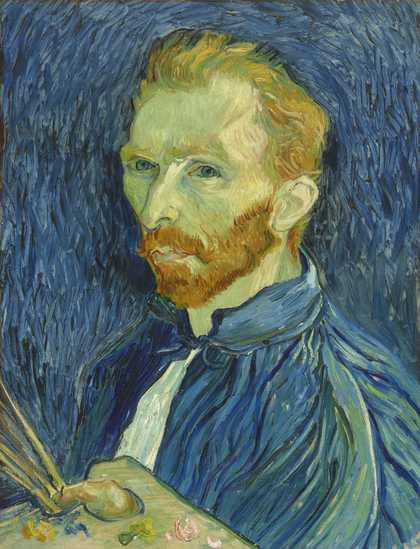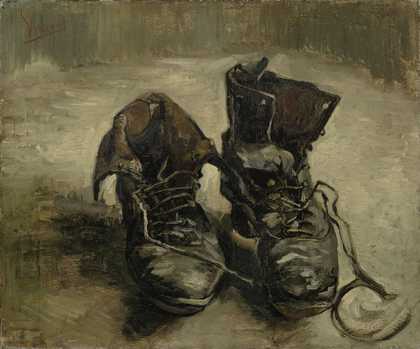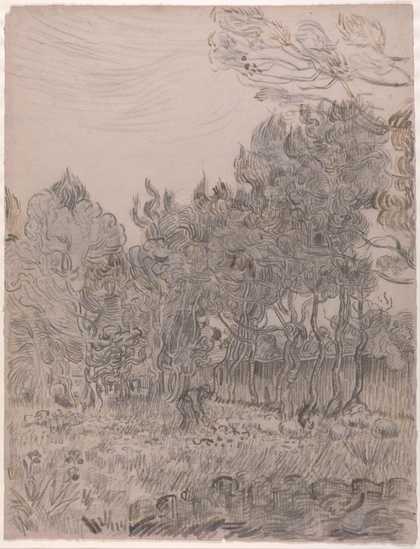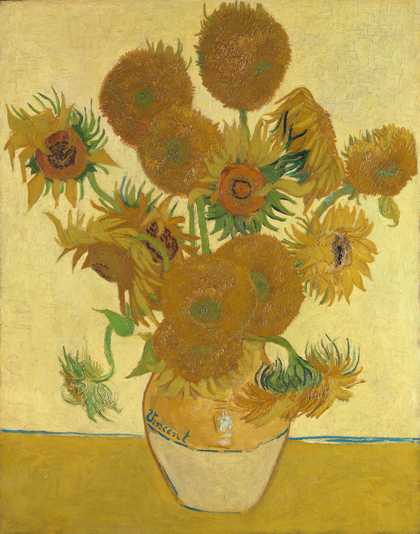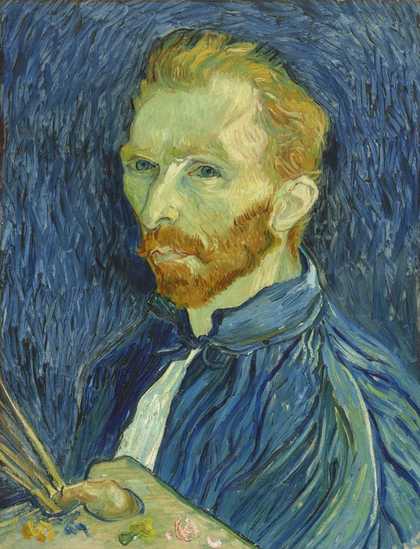
Vincent van Gogh Sunflowers 1888 National Gallery (London, UK)
The young Vincent van Gogh spent nearly three years in England between 1873 and 1876. His love of British culture lasted his whole life and contributed to the style and subject matter of his art. Born in the Netherlands in 1853, Van Gogh tried careers in the art trade and as a teacher and then a preacher before becoming an artist in 1880, at the age of twenty-seven. He died ten years later.
This exhibition is in two parts. The first looks at Van Gogh’s experience in London, the art and literature that caught his attention and its role in his journey as an artist. The second explores the impact of Van Gogh’s art and life on British artists up to the 1950s. The exhibition provides the opportunity to view artworks by Van Gogh afresh, to see British culture through his eyes and to see him through the eyes of the British artists he inspired.
Room 1
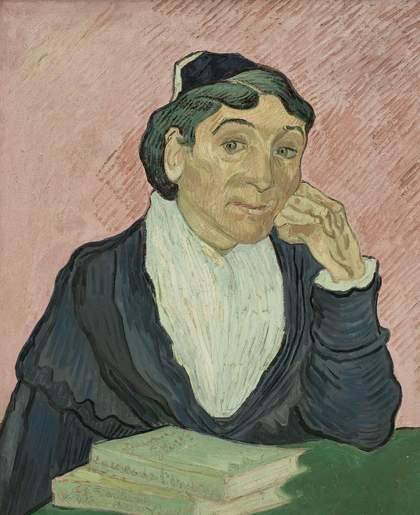
Vincent van Gogh, L'Arlésienne 1890. Museu de Arte de São Paulo Assis Chateaubriand – MASP (Sao Paulo, Brazil)
Foreword
Vincent van Gogh knew four languages, including English, which he spoke and read well. English books were an inspiration and pleasure to him all his life. Van Gogh admired Victorian novels for their ‘reality more real than reality’. He was devoted to Charles Dickens, and wrote, ‘My whole life is aimed at making the things from everyday life that Dickens describes.’
Van Gogh’s letters to his friends and family mentioned many books. These included over a hundred written in English. He wrote to his brother Theo, ‘reading books is like looking at paintings … one must find beautiful that which is beautiful.’
On this bookshelf are English books we know Van Gogh read. Although these are not Van Gogh’s books, they are similar editions to the ones he had. Charles Dickens, George Eliot, Christina Rossetti and William Shakespeare were among his favourite authors.
Room 2
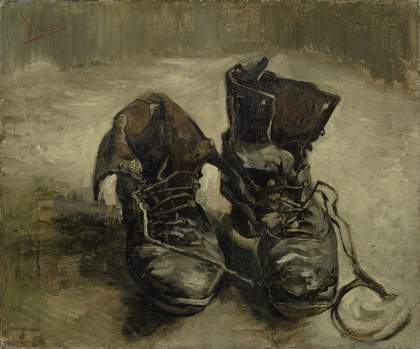
Vincent van Gogh Shoes 1886 Van Gogh Museum (Amsterdam, Netherlands)
Figure on the Road: Van Gogh in England
How I love London.
Vincent van Gogh, 1875
Van Gogh arrived in London in May 1873 at the age of twenty. He worked for two years at the Covent Garden offices of art dealers Goupil and lived in lodgings in Stockwell and Oval in south London. Van Gogh travelled along the river by boat and on the underground railway and he loved to walk through the city.
Radical ideas thrived in Britain and encouraged Van Gogh’s interest in popular religion and concern for the hardship of working people. When he was dismissed from his job, he tried teaching and preaching as careers, in Ramsgate, Kent and Isleworth, west London. In December 1876 he left Britain for good.
In London, Van Gogh immersed himself in culture. He saw paintings in museums, galleries and art dealer’s rooms that he would remember all his life.
Van Gogh was happy at first, but as he learned more of the world and the disappointments of love, his letters home referred to feelings of ‘melancholy’. They talked about life as a difficult journey. Perhaps because of this, he was drawn to images of figures on a road.
After Van Gogh left Britain, he tried to pursue a life of religious service. When these hopes failed his brother Theo suggested he take up art.
I keep thinking about some English paintings.
Vincent van Gogh, 1884
Van Gogh turned to favourite artists and writers for insights, including those he had encountered in London. ‘Studying them more than repays the effort’, he wrote, ‘it’s a different way of feeling, conceiving, expressing … for they are great artists, the English’.
Sometimes, Van Gogh took up themes he had written about in England. He often painted figures on a road through an autumnal landscape. Examples from each part of his artistic career – in the Netherlands and in France – are displayed here.
Room 3
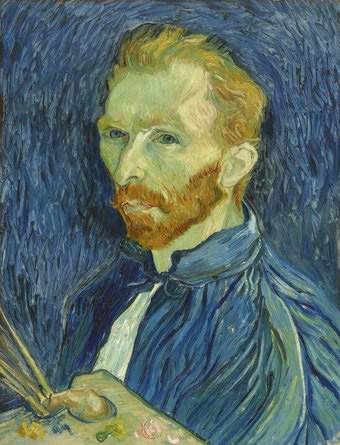
Vincent van Gogh Self Portrait, Autumn 1889 National Gallery of Art (Washington, USA)
Black and White: Becoming a Painter of the People
I often felt low in England … but the Black and White and Dickens, are things that make up for it all.
Vincent van Gogh, 1883
Working in London at art dealer Goupil, Van Gogh was part of the expanding trade in prints and art reproductions and learned about British ‘black and whites’, as they were called. When Van Gogh became an artist four years later, he collected over 2,000 prints.
British illustrators and print-makers were skilled at portraying modern subjects as dramas of light and shade. Although Van Gogh had little formal art training, studying prints helped him find novel compositions and develop his original drawing and painting style.
In this room we see how Van Gogh was thinking about prints throughout his career.
Van Gogh wanted to find ways the artist could contribute to society. He admired the community of artists at the British social reforming newspaper The Graphic. He called them ‘the great portrayers of the people.’ Their wood engravings of modern urban life assisted Van Gogh’s search for subjects in his surroundings.
Having my own studio is too wonderful for words. … I got some splendid woodcuts from ‘The Graphic’… Just what I’ve been wanting for years.
Vincent van Gogh, 1882
British printed books inspired ideas and images that were important to Van Gogh. He was interested in the relationship between art and life. The books he loved affected the way he saw himself and his purpose.
Room 4
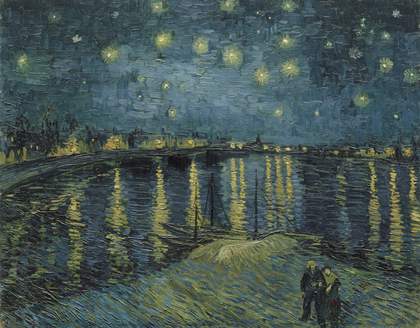
Vincent van Gogh Starry Night over the Rhone 1888 Musée d'Orsay, Paris, France
Cosmopolitans: Van Gogh and British Friends in France
At the age of thirty-two Van Gogh left the Netherlands and joined his brother Theo in Paris. Theo was an art dealer, and Van Gogh met a network of artists, which included English-speaking friends represented in this room.
In France Van Gogh developed his distinct mature style. He spent two years in Paris before moving to Arles in the south to set up an artists’ community. After only ten months, these plans were ended by serious mental illness which began to come back every few months. Van Gogh admitted himself to the Saint-Paul de Mausole hospital, in Saint-Rémy, where he continued to paint.
In spring 1890 Van Gogh moved to the village of Auvers-sur-Oise, near Paris and closer to Theo, where he created a picture nearly every day. On 27 July of that year he shot himself in the chest and died of his wounds two days later.
Room 5
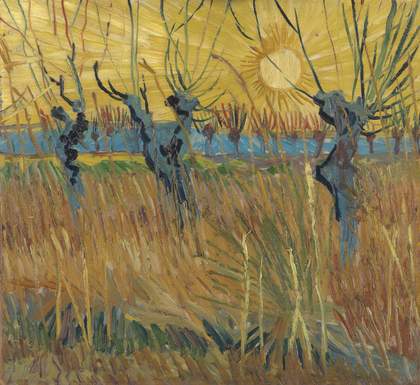
Vincent van Gogh Pollarded Willows, Arles 1888 Kröller-Müller Museum, Otterlo, The Netherlands
Van Gogh, Post-Impressionist
This room looks at the exhibition Manet and the post-impressionists, which introduced British audiences to Van Gogh’s art, twenty years after he died. The title created the term ‘post-impressionist’ to describe the artists in the exhibition.
The paintings shocked people unfamiliar with modern styles, but the exhibition attracted over 25,000 visitors and was a turning point in British culture. Author Virginia Woolf wrote, ‘on or about December 1910, human character changed’.
Criticism of Van Gogh’s paintings focused on his personal history and reflected prejudice and misunderstandings around mental health at the time. Those who praised his work also connected his artistic talent to his illness. A typical comment, by the writer C. Lewis Hind described him as ‘a madman and genius’. These responses have affected how the art of Van Gogh is seen, even today.
It’s a woman dressed in green … Her hair is entirely orange and in plaits. The complexion worked up in chrome yellow. … This wallpaper is blue-green with pink dahlias and dotted with orange and with ultramarine. … Whether I’ve actually sung a lullaby with colour I leave to the critics.
Vincent van Gogh, 1889
Room 6
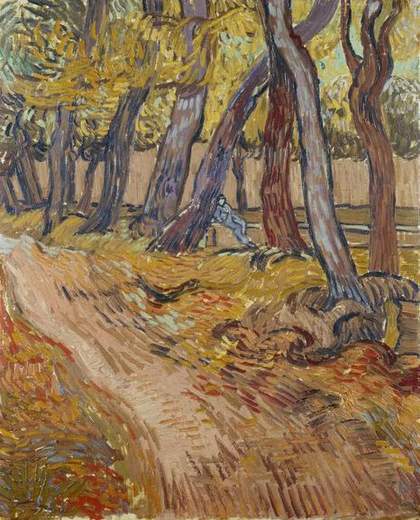
Vincent van Gogh Path in the Garden of the Asylum 1889 Kröller-Müller Museum, Otterlo, The Netherlands
'A Toi, Van Gogh!' Van Gogh and British Artists
In the early years of the twentieth century Van Gogh’s work was viewed most thoughtfully through the eyes of artists. Some British painters embraced the decorative power of post-impressionism. Many were familiar with Van Gogh’s work from exhibitions in Paris, and reproductions in books and prints were becoming available.
Artists such as Harold Gilman, Spencer Gore and Matthew Smith, led by Walter Sickert, were part of new exhibiting societies, including the Camden Town Group. They adapted Van Gogh’s brilliant colours, distinct brush strokes and angled compositions to British versions of his subjects. Gilman kept a print of a Van Gogh’s self-portrait on the wall of his studio. Before he began to paint, he would wave his brush towards the picture, declaring, ‘A toi, Van Gogh!’ (‘Cheers, Van Gogh!’).
Room 7
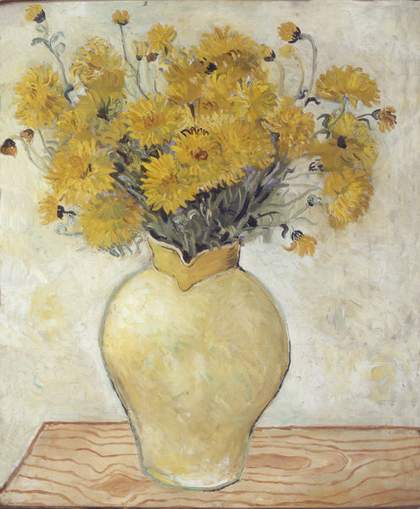
Christopher Wood Yellow Chrysanthemums 1925 Private Collection
Sunflowers: Van Gogh and British Flower Painting
Modern European art has always mistreated flowers, dealing with them at best as aids to sentimentality until Van Gogh saw ... the arrogant spirit that inhabits the sunflower.
Art critic Roger Fry, 1910
Van Gogh painted pictures of sunflowers in 1888 to decorate his house in Arles in the South of France. They were exhibited in major exhibitions in London in 1910 and 1923 and Sunflowers was acquired for the nation by the National Gallery, Millbank (now Tate) in 1924. The painting was transferred to the National Gallery in Trafalgar Square in 1961. It returns to Tate Britain for the first time since then.
Van Gogh’s flower still lifes contributed to a revival of flower painting among modern artists in Britain. Still lifes painted in conversation with Van Gogh’s Sunflowers are on display in this room.
Room 8

Vincent van Gogh At Eternity's Gate 1890 Kröller-Müller Museum, Otterlo, The Netherlands
Drama of a Man: Van Gogh in Britain between the Wars
By the 1920s Van Gogh’s pictures were exhibited regularly in Britain and collected by British individuals and public galleries. He became known to the wider public and established as a modern master.
The English publication of two biographies and Van Gogh’s letters led to his life becoming as famous as his art, and the two became strongly connected. Many British artists walked in his footsteps and interpreted their lives and surroundings in similar ways.
The drama of the man was predicted in his pictures ... We race along with him, breathless – whither? No matter, for we follow a man, a hero, perhaps the last!
Julius Meier-Graefe in Vincent van Gogh, 1922
In 1929, eighteen of Van Gogh’s artworks filled the final room of a large survey of Dutch art at the Royal Academy in London. Paintings in the exhibition included Self-Portrait and Farms near Auvers, both on display in this room.
The catalogue summed up Van Gogh as ‘the brilliant and unhappy genius‘. Stories about Van Gogh’s mental illness, self-harm and death affected the way people looked at his art. The later self-portraits and his last paintings took on extra significance.
Room 9
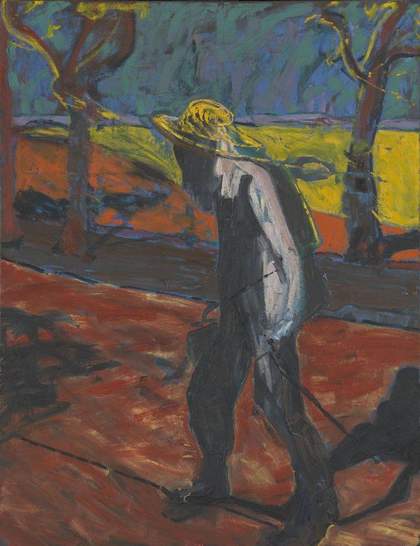
Francis Bacon Study for Portrait of Van Gogh IV 1957 Tate © Francis Bacon Estate, DACS, London
Phantom of the Road: Van Gogh Tragic Hero
During the Second World War, many of Van Gogh’s artworks were hidden to keep them safe and his work was rarely seen. But after the war, he was celebrated in exhibitions, books and films. This included the last Van Gogh exhibition to take place at Tate, in 1947.
The war and its aftermath encouraged the idea of Van Gogh as a tragic and alienated artist whose art expressed the human condition. Some British artists admired this realism and explored the emotional power of his dynamic brushwork and vivid colour.
Today, we look beyond the idea of Van Gogh as a solitary artist. We appreciate his work in vivid and changing dialogue with the culture and ideas of his times and those that have followed.
This artist did face the reality of existence, however disconcerting, rather than close his eyes before the tragic futility of inhuman life!
Oskar Kokoschka in Van Gogh’s Influence on Modern Painting, 1953

